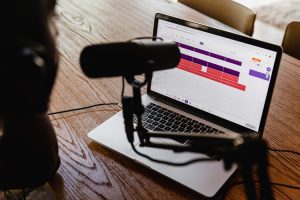 A friend of mine said Amazon had delivered her ring light and microphone, but then she realized she had no idea how to get started with video.
A friend of mine said Amazon had delivered her ring light and microphone, but then she realized she had no idea how to get started with video.
I have done multiple video series over the last nine years, so here’s some advice from yours truly, and my go-to video expert – Lou Bortone.
Facebook Live (or YouTube)
If you have a personal profile on Facebook or a business page, doing a Facebook Live is one of the easiest ways to start.
If you use your phone, there are very few setup options or questions to answer.
Using your laptop has more options, so it may be frustrating the first time, but after that, you’ll have it down.
People expect you to be real and unscripted on a Facebook Live, so the bar is very low. If you hate it, delete it.
If you’re truly terrified that you’ll look like an idiot, you can set the visibility setting to where only you will see it.
Basically, go live and talk. You know how to talk. You’ve been doing it since you were a toddler.
Bonus points if you can string a coherent sentence or two together!
Doing a Facebook Live hosts the video on that platform for you, so there’s no file download / upload required.
BTW, you have the same option on YouTube, if you prefer that platform.
Loom
But let’s say you’re not on Facebook or don’t feel comfortable with that. Another great option is Loom. (Yes, there’s a free version.)
There are options on how close up you want to be in the shot, which is great if your background is messy. A tight shot is primarily your face with very little background showing.
(Loom is also great for doing a video about a landing page with a link to get to that page as part of a launch, but that’s a topic for another day.)
As with a Facebook Live, the video is hosted on Loom, and there are some basic editing tools available within the software. It’s pretty simple to use. Even I figured it out.
Once you’re done with your video, you can share the hyperlink like you would any content. It links well with social channels. You can embed videos, too.
Bonus: There’s a plug-in that allows you to send video emails, which is super cool. FYI, video emails have an incredibly high open rate and can be the PERFECT follow-up to sign up that client, depending on the business you’re in.
Zoom
Zoom is the platform I use the most for videos. A lot of people have challenges adjusting to talking to the light on their camera (phone or laptop), so it can be easier to have a conversation or interview someone as you’re getting used to doing video.
My current process is: I walk around my house talking to myself, and when I think I have something interesting to say, I jump on Zoom, hit “record to this computer,” and blather on until I get whatever idea I am noodling on out of my system.
When I exit the session, Zoom converts the file. I then drop it into my video editing software and I edit out the parts where I rambled. (Since I rarely make notes and never use a script, there can be some parts where I go off the rails…)
Over time, I have gotten more skilled with video editing, so now I also might add an intro, outro, lower third, and overlays – but you don’t have to do any of that.
Seriously. Keep it simple and just start posting videos. (Here’s 55 statistics to convince you to do this.)
I then export the file from the video editing software as a .mp4 file and upload it to YouTube, LinkedIn, and Facebook.
This is a little more work, but you can get a polished product with minimal technical skills. I get a lot of compliments on my videos, and they get me clients, too.
But don’t take my word for it! Here’s “video wise guy” Lou Bortone’s advice.

